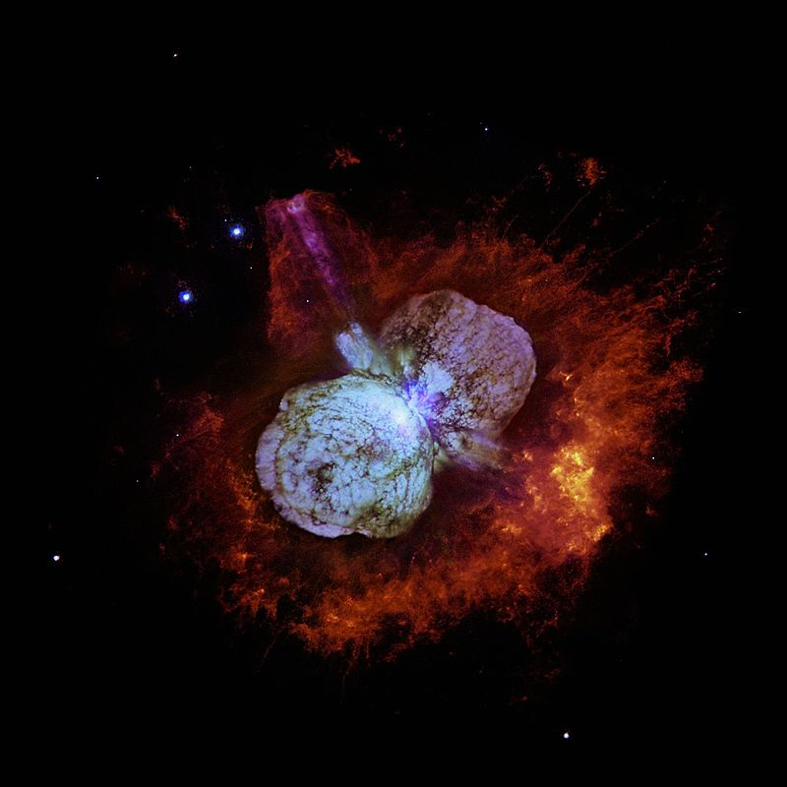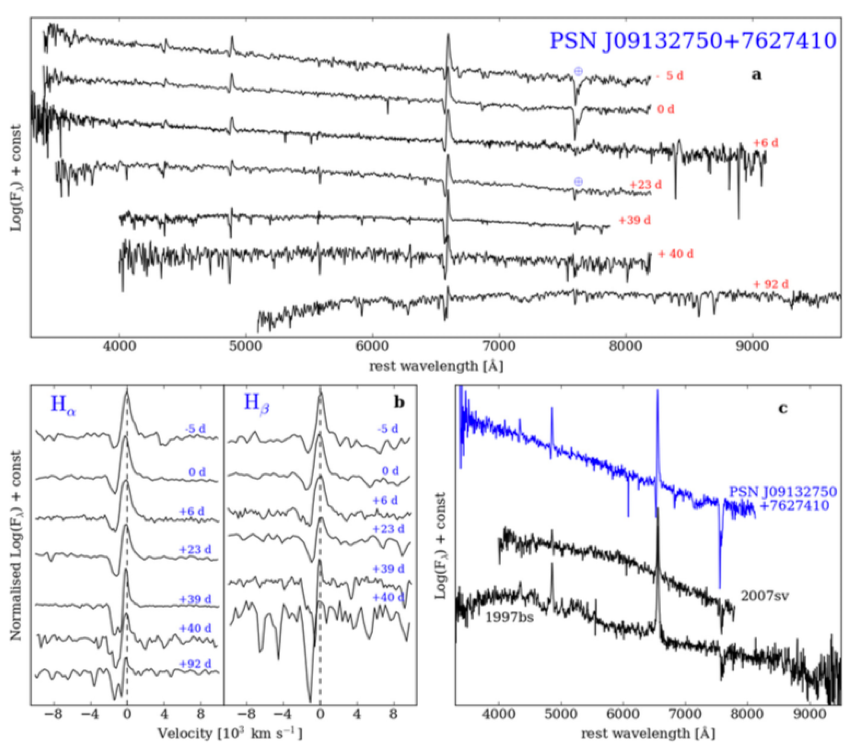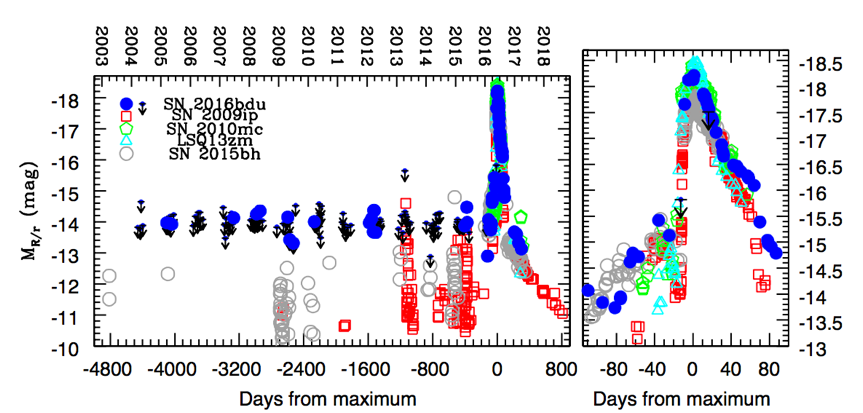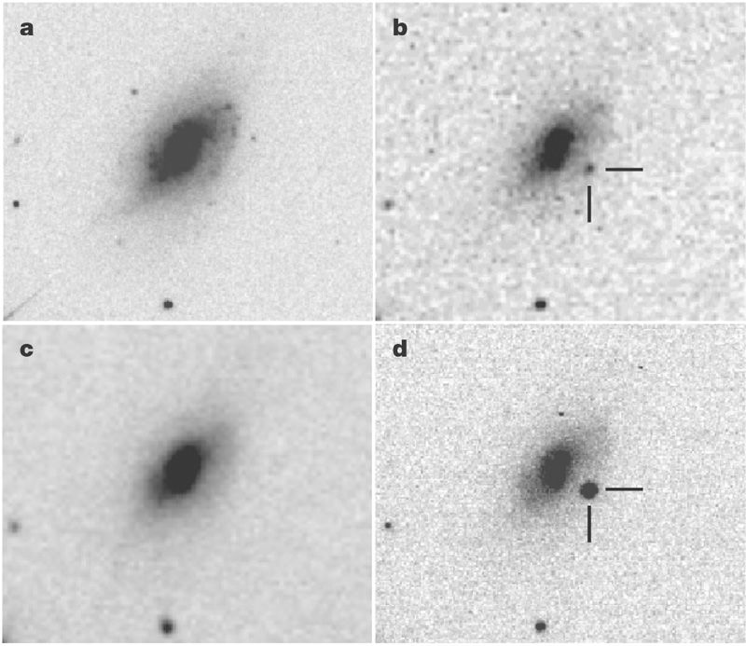Padova-Asiago Supernova Group
Giant eruptions of luminous blue variables
Luminous blue variables (LBVs) are very massive star that occasionally experience luminous eruptions, becoming the most luminous objects in the galaxies. The most famous example in the Milky Way is Eta Car, that produced a famous Giant Eruption in the mid-19th century. Such eruption produced the complex circumstellar environment knows as the Homunculus Nebula (Fig. 1).

Fig. 1 HST image showing the Homunculus Nebula surrounding the Eta Carinae. The complex structure of the nebula was produced in the 19th Century Giant Eruption of this Galactic LBV. Credits: N. Smith, and NASA.
Occasionally, LBVs and types of massive stars produce isolated outbursts that may reach luminosities comparable to those of giant eruptions (e.g. Tartaglia et al. 2016, ApJ, 823, L23), but with a rapid evolutionary time scale (from weeks to a few months). In other cases, multiple outbursts are observed during an LBV eruptive phase which lasts years to decades, and whose individual light curve peaks reach absolute magnitude -14 mag (Pastorello et al. 2010, MNRAS, 408, 181). Although the massive progenitor survives these eruptive events, the individual transient event mimics, in terms of energetics and spectral appearance, a true SN explosion. In particular, their spectra resemble those of Type IIn SNe (Fig. 2). For this reason, extragalactic LBV-like outbursts are frequently dubbed SN impostors (Van Dyk et al. 2000, PASP, 112, 1532, Pastorello & Fraser, Nat. Astron., 3, 676).

Fig. 2 Spectral evolution of the single-outburst Gap Transient PSN J09132750+7627410; and comparisons with similar transients. Figure from Tartaglia et al. 2016.
Publications:
- Tartaglia et al. 2016, ApJ, 823, L23
- Tartaglia et al. 2015, MNRAS, 447, 117
- Pastorello et al. 2010, MNRAS, 408, 181
- Maund et al. 2006, MNRAS, 369, 390
Stellar eruptions heralding the explosion of Supernovae IIn and Ibn
One of the most exciting astrophysical discoveries in recent years is that a growing number of supernova impostors are followed by a termina SN explosion occurring a few months to years later. The chain of event usually produce an hydrogen-rich Type IIn supernovae (Pastorello et al. 2018, MNRAS, 474, 197 ; see Fig. 3).

Fig. 3 Pre- and post-explosion light curves of a sample of Type IIn SNe. Figure from Pastorello et al. 2018.
Although SN impostors are preferentially followed by Type IIn SN explosions, a stellar outburst was also observed before the explosion of a SN Ibn. This single outburst occurred in October 2004 in the galaxy UGC 4904, and was followed after two years by the explosion of the Type Ibn SN 2006jc (Pastorello et al. 2007, Nature, 447, 829; Fig. 4). The 2004 event was interpreted as an outburst of a Wolf-Rayet star, which exploded as a luminous, stripped-envelope core-collapse SN.

Fig. 4 UGC 4904 in 2001 (a), 2004 (b), 2005 (c) and 2006 (d). A stellar outburst of a Wolf-Rayet star is detected in 2004 (panel b), two years before the explosion of SN 2006jc (panel d). Image from Pastorello et al. 2007.
Leading researchers: N. Elias-Rosa, A. Reguitti, A. Pastorello, L. Tartaglia.
Collaborators: M. Fraser, E. Callis, S. J. Brennan, R. Kotak, S. Moran, E. Kankare, V. Goranskij, E. Barsukova, G. Pignata, K. Misra, P. A. Mazzali, and the Padova SN group.
Publications:
- Reguitti et al. 2022, A&A, 662, L10
- Brennan et al. 2021b, MNRAS, 513, 5666
- Brennan et al. 2021a, MNRAS, 513, 5642
- Pastorello et al. 2019, Nat. Astron., 3, 676
- Pastorello et al. 2019, A&A, 628, 93
- Reguitti et al. 2019, MNRAS, 482, 2750
- Elias-Rosa et al. 2018, ApJ, 860, 68
- Elias-Rosa et al. 2018, MNRAS, 475, 2614
- Pastorello et al. 2018, MNRAS, 474, 197
- Elias-Rosa et al. 2016, MNRAS, 463, 3894
- Tartaglia et al. 2016, MNRAS, 459, 1039
- Benetti et al. 2016, MNRAS, 456, 3296
- Pastorello et al. 2013, ApJ, 737, 1
- Pastorello et al. 2007, Nature, 447, 829